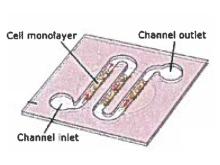BACKGROUND
Endothelial cell-based assays are essential tools in biomedical research and drug discovery, enabling the study of cellular responses to various stimuli (e.g. immune cells, platelets, circulating tumor cells, circulating stem cells). Traditional cell-based methods often rely on multi-well plates and manual pipetting, which are labor-intensive, prone to variability, and limited in throughput. Microfluidic technologies have emerged as promising alternatives, offering precise control over fluid dynamics and cellular microenvironments. However, many existing microfluidic systems are complex to fabricate, difficult to scale, or lack compatibility with standard laboratory equipment. There remains a need for a modular, scalable, and user-friendly microfluidic platform that supports high-throughput, reproducible cell-based assays.
TECHNOLOGY
Researchers at the University of Toronto have developed a novel microfluidic device designed for efficient endothelial cell-based assays. The device comprises three main components: a well block with multiple microwells, one or more cell culture layers (including microchannels or chamber wells), and a base block. These layers are sealably coupled to allow fluid communication between the microwells and the culture layers (Figure 1). The design supports both static and dynamic culture conditions and enables multiplexed assays. The modular architecture allows for easy assembly and disassembly, facilitating cleaning, reuse, and integration with standard lab workflows.

Figure 1. Cross-section of one well in the current 96-well microfluidic transmembrane platform. The assembly is mounted on a vacuum manifold which pulls fluid from the well block through the MF channel. Media, drugs/reagents (green), and suspended cells (red) can be contained withing the well block. Arrows show the fluid path.
COMPETITIVE ADVANTAGE
- High Throughput: Supports parallel processing of multiple samples, increasing assay throughput significantly.
- Modular Design: Enables easy customization and scalability for different experimental needs.
- Enhanced Reproducibility: Reduces variability through precise fluid control and standardized architecture.
- Compatibility: Integrates with existing lab infrastructure, including microscopes and robotic handlers.
- Cost-Effective: Reusable components reduce long-term operational costs compared to disposable systems.
APPLICATIONS
- Basic research in cell biology and tissue engineering
- Drug screening and pharmacological testing
- Toxicology studies
- Personalized medicine and patient-derived cell assays
INTELLECTUAL PROPERTY STATUS
- Granted US Patent (US10481150B2)
PROJECT STATUS
The technology has been validated in laboratory settings. Dose-dependent adhesion of leukocytes to endothelial cells activated by TNFa has been tested.
KEYWORDS
microfluidics, cell-based assays, high-throughput screening, lab-on-a-chip, drug discovery, tissue engineering, cell culture, diagnostics, modular device, biomedical research





